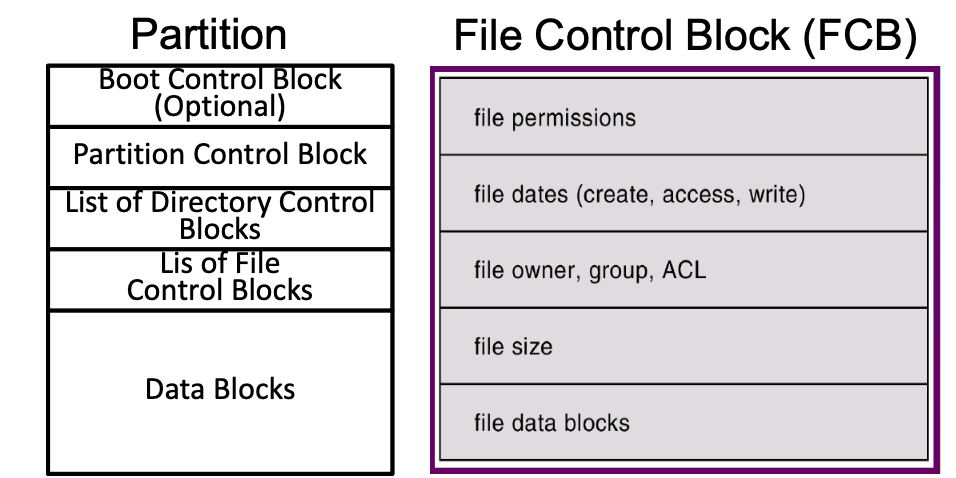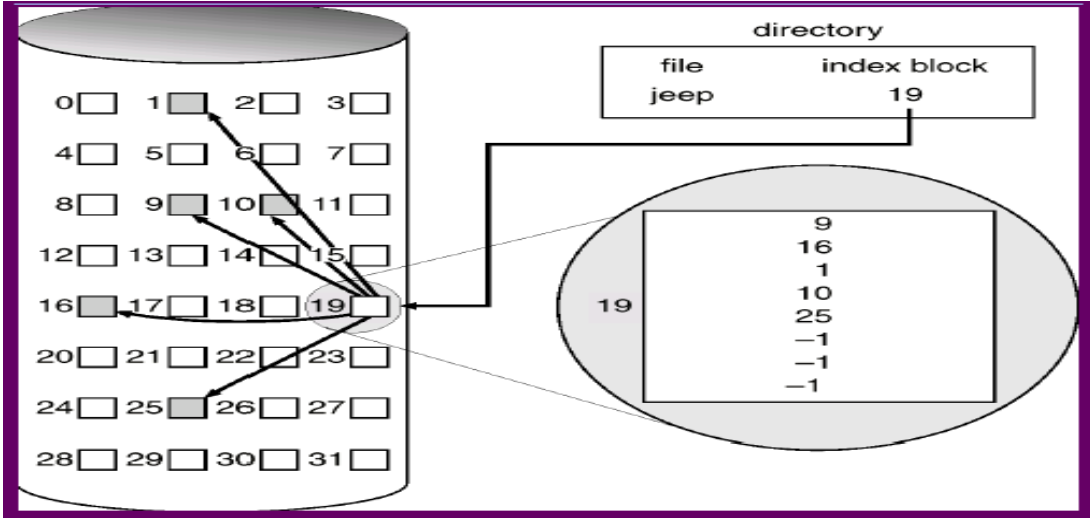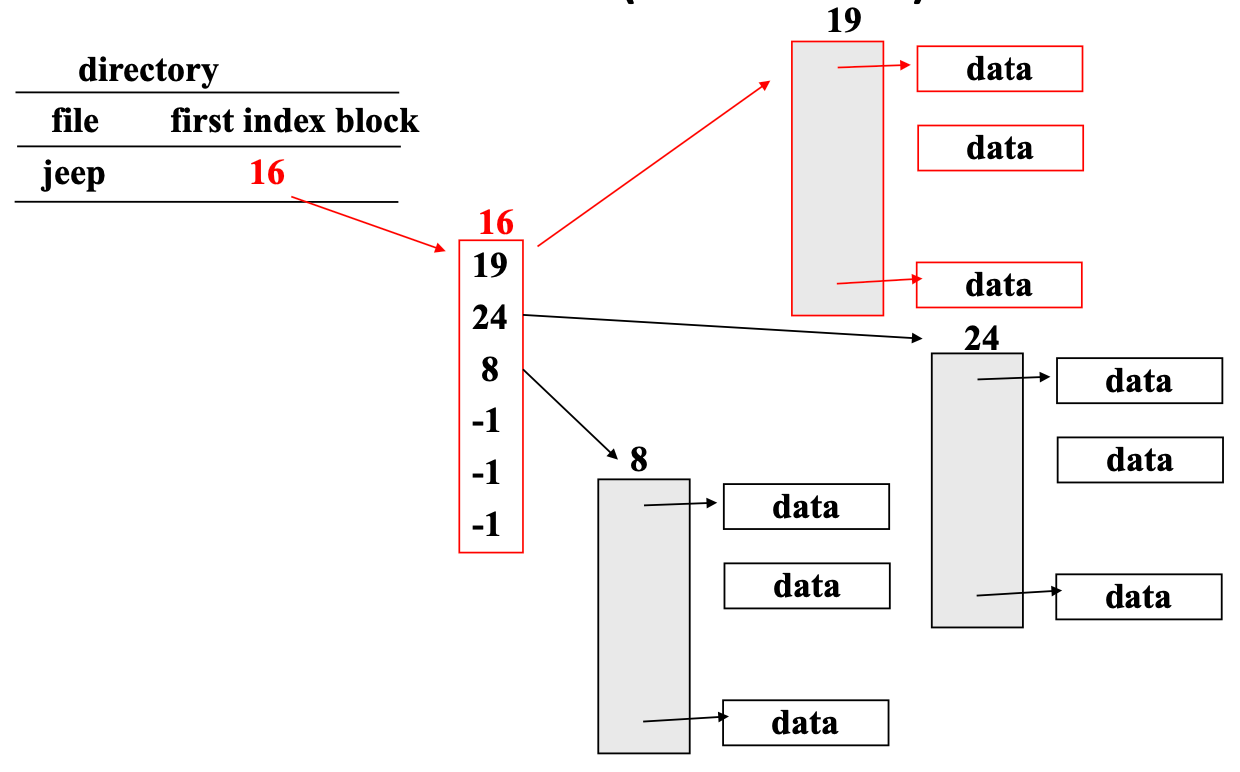[OS] Chapter 11 — File System Implementation
File-System Structure
- 一個 disk 提供的最小單位是 sectors(usually 512 bytes)
- 但是 mapping 的時候不喜歡用 sector,太小了
- 所以都用 Blocks,通常是四到十幾個 sectors
- 一個 OS 可以 support > 1 個 FS type
- 需要兩個 interface
- 對上:user programs
- 對下:physical storage (disk)
Layered File System
- 最上層是 API
- 最下層(最終要寫到 disk 上面去的)要透過 driver 寫過去,那 driver 要的是單位是 sector
- Logical file system — 根據 file path 找到 file ID,也要去判斷權限(i.e. 判斷 API 是不是合法可執行的東西)
- File-organization module — 每一個 FS 最不一樣的地方。要找到在 logical 中的位址對應到的 physical 的地方。(甚至需要 map 到不同的電腦)
- Basic File system — 最基本的 I/O 的動作(跟檔案管理無關啦)

之所以一個
fread可以對不同的 file system 作操作就是中間有 FS manager (VFS — Virtual File System)
File System Implementation
On-Disk Structure
→ 因為 reboot 後,資料還是要在,所以和之前的不一樣
- Boot control block ****(per partition) — 關於
booting 的 code 或資訊
- 裝 OS 他就會幫你 create 起來
- 一個 partition 只會有一個(也最多一個) boot control block,通常會放在最上面
- 如果不是開機槽,那就不會有這個 block
- Unix File System → boot block; NTFS → partition boot sector
- Partition control block ****(per partition) — 關於這個 partition
的資訊
- details: # of blocks, block size, free-block-list, free FCB pointers, etc
- UFS → superblock; NTFS → Master File Table
- 如果沒有 boot control block,那他應該會在最前面
- File control block (per file) — file 的 metadata
- 注意不存 data,data 會有一個指標指過去
- UFS — inode; NTFS: stored in MFT (relational database)
- Directory structure (per file system): organize files

$ stat
In-Memory Structure
→ 一樣的,只是哪些東西要被 load 到 memory 裡面
- in-memory partition table — 有人被 mount,他就會存關於這個 partition 的資訊。Unmount 就會被移除。
- in-memory directory structure — 最近 accessed 到的 directory
- system-wide open-file table — 被 open 的 file 的 file control block
- per-process open-file table — process 對於一個 file 需要 keep 的資訊,且 file close 的時候,他就會被清掉,不會寫回去。
File-Open

- 如果沒讀過這個 directory,他就會去 disk (secondary storage)的地方把他拉出來
- Directory 的最後接的是 file control block
File-Read

- 上面 open 好了,所以兩個 open-file table 都 ready 了
- 去 per-process 確認有沒有權限(logical file system)
- 如果有,去 system-wide 找 file control block 裡面存的 data block 的 pointer
File-Create
- OS allocates a new FCB
- Update directory structure
- OS read in the corresponding directory structure into memory
- Updates the dir structure with the new file name and the FCB
- (After file being closed), OS writes back the directory structure back to disk → Close 才會寫回去,因為 disk 太慢了
- The file appears in user’s dir command
Virtual File System
- Four main object types defined by Linux VFS Disk Allocation Methods
- inode (FCB) → an individual file
- file object → an open file (per process)
- superblock object → an entire file system
- entry object → an individual directory entry
Directory Implementation
大型系統的 directory 太大了,且掉了很慘
- Linear lists
- use link list and traverse
- easy to program but poor performance
- Hash table
- 把 file path 當成 key,FCB 是 value
- constant time for searching
- linked list for collisions on a hash entry
- hash table usually has fixed # of entries
Review Slides (I)
- Transfer unit between memory and disk?
- App → LFS → FOM → BFS → I/O Control → Devices
- on-disk structure
- Boot control block, Partition control block
- File control block, Directory structure
- In-memory
- Partition table, Directory structure
- System-wide open-file table
- Per-process open-file table
- Steps to open file, read/write file and create file?
- Purpose of VFS?
Allocation Methods
把 file 對應到 block。
Contiguous Allocation

- 一個 block 一定只屬於一個 file
- Sequential access 和 random access 都很有效率(根據 I/O 的次數作判斷)→ random 是因為可以用算的飛過去
- ☹️ Problems
- External fragmentation → compaction(硬碟清理)
- File cannot grow(會被後面卡住)→ 搬移資料(big cost)
Extent-Based File System (Ext)
- 用 link list 的方法把 extent 串起來
- 所以除了存 start 和 length,還要多存 pointer to next extent
- ☹️ Problems
- Random access become more costly
- “Internal fragmentation” → extent 給他的 blocks 沒用完
Linked Allocation

- 把下一個 block 的 pointer 存在 data block 裡面,dir 只會有第一個 pointer
- Only good for sequential-access files, random access need to traverse through the link list
- Each access to a link list is a disk I/O (because link pointer is stored inside the data block)
- 每一個 data block 都會浪費 4 byte 去存 pointer
- Reliability → 斷了就 GG
FAT (File Allocation Table) file system

- 把整個 pointers 存起來,所以就變成一個純 link list,存取還是需要 traverse,但是不用 I/O,只會有很快的 memory access
- 超快,但是需要空間
- Link 斷了也 GG
Indexed Allocation

- 跟剛剛很像,但是他是用 index,不用 traverse
- 很快,random 也超快
- 注意那個 index 也是存在 disk 上了,他也是一個 block
- 所以 inode 會存那個 index 在的 block
- ☹️
- Index block 很浪費空間,小的 block 根本用不完
- Index block 如果不夠大?
Linked Indexed Scheme
→ search time 會變長

Multilevel Scheme (two-level)
→ 大 file 這個比較優
→ 小 file 就很浪費

Combined Scheme: Unix inode
根據 file size 決定用哪個

Free-Space Management
- 找到全部的 free block
- Free-space list: records all free disk blocks
- Scheme
Bit vector

- 用一串 1 和 0 去紀錄他是不是 free 的
- 🙂 simplicity, efficient
- ☹️ 因為是 fix size,會浪費 memory 空間
Linked list (same as linked allocation)

Grouping (same as linked index allocation)
Counting (same as contiguous allocation)
→ keep the address of the first free block and # of contiguous free blocks
Review Slides (II)
- Allocation:
- Contiguous file allocation? Extent-based file system?
- Linked allocation?
- Indexed allocation?
- Linked scheme
- multilevel index allocation
- Combine scheme
- Free space:
- Bit vector, linked list, counting, grouping
Textbook Questions



此筆記為清華大學周志遠教授作業系統之課堂筆記,所有內容及圖片皆取材於課堂內容。
如內容有誤,歡迎來信 mail@arui.dev。